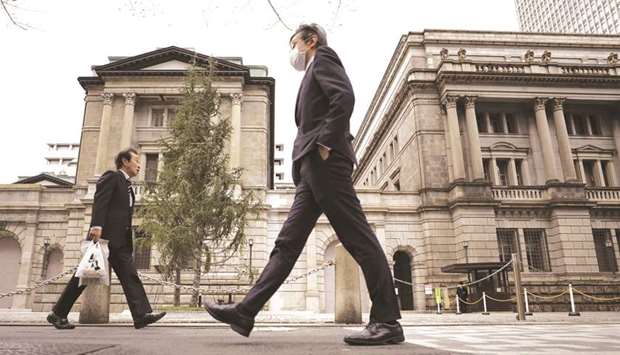For the first time since Haruhiko Kuroda took the helm in 2013, the Bank of Japan isn’t projecting more optimism than private economists in a shift in its messaging facilitated by Covid-19.
While helping support companies, ease liquidity issues and stabilise markets since March, the BoJ has also de-emphasised the link between prices and its policy stance, and dialled back its forecasts to more realistic levels.
The change leaves the central bank more in line with economists’ projections and less likely to take additional action to pursue its inflation target once the impact of the pandemic subsides.
“The BoJ has finally come back to Earth,” said Kyohei Morita, chief Japan economist at Credit Agricole Securities Asia BV. “With these moves, it looks likely that the BoJ has positioned itself to stay in persistent easing mode once the pandemic is over and avoid a need to take more drastic action.”
The central bank now sees inflation this fiscal year averaging -0.5% compared with a 1% projection back in January, making it clearly more pessimistic than Bloomberg’s median forecast of economists for one of the first times in more than seven years.
In 30 quarterly projections under Kuroda’s watch, the July forecasts marked the first occasion that the BoJ didn’t even see inflation reaching the halfway point toward its 2% target within a three-year time frame.
The gloomier forecasts come after the central bank dropped a baffling guideline to increase its government bond holdings at an annual pace of ¥80tn that was out of sync with net purchases last year of around ¥15.8tn.
The BoJ also dropped the link between price momentum and additional easing in its policy guidance.
The shift suggests Covid-19 has put an end to the BoJ’s hope for achieving its price target in the foreseeable future and its intention of influencing expectations through aspirational projections.
It also likely means the BoJ will stick with its current easing framework unless the economy buckles further or an overly strong yen emerges in the post-virus era.
BoJ officials saw the bond guidance as increasingly meaningless following the virus crisis, according to people familiar with the matter. They also wanted to remove any hint of a limitation on bond buying should the government’s fiscal response prove bigger than expected, according to the people.
By keeping interest rates low the bank is helping the government borrow at little cost, ensuring a policy mix without any additional moves.
“With the pandemic pushing inflation away from the 2% target, it is better for the Bank of Japan’s communication with the market to have a more realistic price outlook.
While it’s a painful setback, the upheaval caused by the virus offers a chance to shift the price target to a medium or long-term goal”, says Yuki Masujima, Bloomberg economist.

Pedestrians walk past the Bank of Japan headquarters in Tokyo. While helping support companies, ease liquidity issues and stabilise markets since March, the BoJ has also de-emphasised the link between prices and its policy stance, and dialled back its forecasts to more realistic levels.
